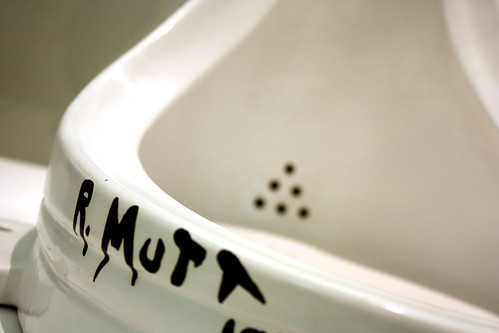Fountain is an artwork created by Marcel Duchamp in 1917 while he was living in New York. It is the most emblematic object from the series of pieces that Duchamp called “readymades”, pieces or manufactured objects that were picked by the artist in everyday life and that got elevated to art just by choice of the artist who then puts his signature on them. In the case of Fountain, Duchamp signed “R. Mutt 1917”. He signed it on a white porcelain urinal he bought in a sanitary supply store in Manhattan and which he will turn upside down to make it look like a fountain.
At the time, Duchamp, as a board member of the Society of Independent Artists in New York submitted the piece, under this fake name supposedly to hide his involvement with the piece, to their 1917 exhibition, which had been proclaimed to exhibit all work submitted in a democratic way. Yet after much debate by the board members about whether the piece was art or not, Fountain was hidden from view during the show. Even though only a handful of people had seen this piece, and even if it wasn’t exhibited to the general public and there wasn’t really a scandal involved, Fountain went on to become one of the 20th century’s most emblematic pieces of art.
Duchamp proposes here not only to see something we would see in everyday life from a new perspective, but also goes ahead and tries to de-deify the persona of the artist himself. He makes the viewer ask himself: “Is it really art just because the artist said so?”
In a 1917 art and Dada journal The Blind Man published in New York, the Dadaists reported on Fountain and published also a photograph of the piece, taken by Alfred Stieglitz. The accompanying text makes an important claim on Fountain that has proven to be pivotal to many art forms that would be coming after it:
“Whether Mr. Mutt made the fountain with his own hands or not has no importance. He CHOSE it. He took an article of life, placed it so that its useful significance disappeared under the new title and point of view – created a new thought for that object.” Later in his life, Duchamp would explain his original intent was to shift the focus from art as a form of physical craft to an intellectual interpretation of the art form itself.
Though the original piece was lost shortly after the exhibition in 1917, Duchamp allowed reproductions of Fountain to be made in an edition of eight copies in 1964.
Finally, it is interesting to see that Fountain is still stirring up the minds of artist nowadays. In 2006 while on display in the great Dada show in the Pompidou Centre, Fountain was attacked by Pierre Pinoncelli, a French performance artist, with a hammer causing a slight chip. Pinoncelli said the attack was a work of performance art and even Duchamp would have appreciated. In 1993 Pinoncelli already urinated into the piece while it was on display in Nimes.

Labels: Art, MUSEUMS, pompidou, TOILETS of NEW YORK

























Bonjour! Cedric,
Being an artist, I'am totally familiar with artist Duchamp and his famous "Fountain signed “R. Mutt 1917”
Wow! what an interesting piece and
I'am pleasantly, surprised to learn that O'Keeffe's(One of my favorite artist) hubby Steiglitz, had taken a photograph of the piece.
Cedric said,"(I just so remembered it be good to put it up here instead of letting it rot away in the vaults of my hard disk.)"
I agree with you, wholeheartedly,
I'am so very happy that you posted it!...
...Merci,for sharing!
DeeDee ;-D
Have you gone to NYC yet for the summer?